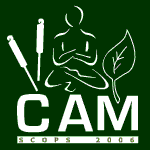What should students learn about CAM?
 It’s documented here and here that American medical students want to learn more about CAM.
It’s documented here and here that American medical students want to learn more about CAM.
But what should the curriculum look like?
Here are the 3 key principles that 15 National Center for Complementary and Alternative Medicine (NCCAM)-funded education programs found useful when developing CAM coursework.
First, teach foundational CAM competencies to give students a framework for learning about CAM.
- Understand why patients use CAM.
- Learn how to ask about and discuss CAM with patients in a nonjudgmental manner.
- Understand the basic tenets of alternative healing systems, such as traditional Chinese medicine and naturopathy.
Second, choose specific content based on evidence, demographics, and conditions that are most appropriate for CAM therapies.
- Emphasize CAM therapies with evidence of success in treating conditions not effectively treated by allopathic medicine.
Third, provide students with skills for future learning, including where to find reliable information about CAM and how to search the scientific literature and assess the results of CAM research. Examples include…
- Medline Plus — Herbs and Supplements
- Natural Standard AMSA (American Medical Student Association)
The bottom line?
Many other resources to help students keep up with CAM are listed in the article. But inexplicably, they missed this one.
10/10/07 20:51 JR